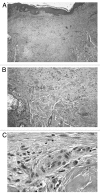Tissue repair: The hidden drama
- PMID: 21220961
- PMCID: PMC3055648
- DOI: 10.4161/org.6.4.12555
Tissue repair: The hidden drama
Abstract
As living beings who encounter every kind of traumatic event from paper cut to myocardial infarction, we must possess ways to heal damaged tissues. While some animals are able to regrow complete body parts following injury (such as the earthworm who grows a new head following bisection), humans are sadly incapable of such feats. Our means of recovery following tissue damage consists largely of repair rather than pure regeneration. Thousands of times in our lives, a meticulously scripted but unseen wound healing drama plays, with cells serving as actors, extracellular matrix as the setting, and growth factors as the means of communication. This article briefly reviews the cells involved in tissue repair, their signaling and proliferation mechanisms, and the function of the extracellular matrix, then presents the actors and script for the three acts of the tissue repair drama.
Figures







References
-
- Kumar V, Abbas AK, Fausto N, Aster JC. Tissue renewal, regeneration and repair. In: Robbins, Cotran, editors. Pathologic Basis of Disease. Eighth ed. Philadelphia: Elsevier; 2010. pp. 79–110.
-
- Conover JC, Notti RQ. The neural stem cell niche. Cell Tissue Res. 2008;331:211–224. - PubMed
-
- Bessa PC, Casal M, Reis RL. Bone morphogenetic proteins in tissue engineering: the road from laboratory to the clinic. Part 1-basic concepts. J Tiss Eng Regen Med. 2008;2:1–13. - PubMed
Publication types
MeSH terms
Substances
LinkOut - more resources
Full Text Sources
Other Literature Sources
Research Materials
